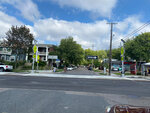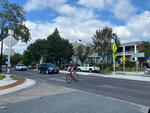By Cam Gordon
The reduction of traffic lanes on Lyndale Ave from 31st St. to Franklin Ave. has improved safety and will remain in place.
Called the “4-3 Lane Pilot Project,” Hennepin County staff told the Minneapolis bicycle advisory committee (BAC) on June 13, 2023 that after conducting traffic analysis and collecting feedback they will keep the three-lane restriping. Plus, they will use the information received from pilot study to inform the final design of Lyndale when it is fully reconstructed in 2026.
Lane reductions from 4-3 are not new in the state or county. They involve taking a four-lane undivided roadway, with two lanes of traffic going in each direction, and restriping them to include only one lane going in each direction with a left-turn-only center lane. Sometimes right-turn-only lanes are also included at busier intersections.
Deanna Newman is the BAC Ward 7 representative and vice chair of the engineering committee where the presentation on Lyndale’s pilot was made. “The BAC generally supports 4-3 lane conversions as a way to calm traffic and make room for multi-model infrastructure like sidewalks, greenspace and bike lanes,” said Newman. “The members support doing similar pilots in the future as a way to get real-time community feedback and identify areas for improvement.”
In 2019, when Minneapolis public works staff evaluated traffic crashes on 11 streets that had 4-to-3 lane conversions between 2004-2012, they found that there was a 36% average decrease in injury crashes and a 25% average decrease in all crashes after a conversion.
“We know that four-lane undivided streets in urban environments have particular challenges,” said Ethan Fawley, the city’s Vision Zero Program Coordinator, “A 4-3 safety conversion is a common and frequent adjustment that can be made at low cost.”
The city’s 2023 Minneapolis Vision Zero Action Plan aims to end all traffic-related fatalities. It includes strategies to “proactively implement safety conversions (for example, 4-to-3 lane safety conversions) or other safety treatments to address city-owned high-injury 4-lane undivided streets,” and aims to partner with Hennepin County and the Minnesota Department of Transportation to implement such conversions on the four-lane undivided streets they own.
Last year, 31st St. E. saw such a conversion and, in 2021, so did Lyndale Ave. North. Lake St., which Fawley says is “the highest crash street in Minneapolis,” is being converted this year and next as part of the B-Line bus rapid transit improvements. Plans are also in place to do the same on Hennepin Ave. in Uptown and on Franklin Ave.
First, a pilot project
The Lyndale pilot was started following concerns being raised about dangerous driving and too many crashes. In the city’s 2017 pedestrian crash study, the Lake St. and Lyndale Ave. intersection had the highest number of pedestrian crashes in the city over 10 years. The intersections at 26th St. and Franklin had the 10th and 23rd highest. Left turning vehicles accounted for nearly half of all crashes.
In July 2022, following organizing work by the advocacy group, Our Streets Minneapolis, and with the support of Hennepin County commissioner Marion Greene (who identified a safety overhaul of Lyndale as her top public works priority), the county restriped Lyndale between Franklin Ave. and 31st St.
“The conversion has been a big success. My office has received a tremendous amount of positive feedback, and transportation staff are encouraged by the data they are seeing and hearing from the majority of users,” said Greene. “The investments have changed the way residents and neighbors interact with the street and their neighborhoods, in ways that engender community connectivity, active living, transit use, and safety for all users.”
In addition to the lane reduction, the pilot on Lyndale changed the intersections at 29th, 27th and 25th streets. This included prohibiting left turns at some intersections, adding concrete mediums and more traffic signs, and installing flashing pedestrian crossing beacons at 25th and 27th.
CRASHES DOWN A YEAR LATER
A year later, the county reported that there has been a 57% decrease in all crashes and a 48% decrease in injury crashes. They also found that at 25th St., vehicles were 92% more likely to stop for a pedestrian, and that speeds have gone from above the speed limit to below it. According to the report, 85% of drivers prior to the pilot would reach up to 39 mph. After the conversion, that 85 percentile speed went down to 29 for those going north and 25 for those going south.
Pedestrian behavior also changed, with less illegal crossings and an increase in pedestrian crossings by 86% at the three improved intersections, especially at 25th and 27th.
IS TRAFFIC SLOWER?
One concern raised about 4-3 lane conversions is that they delay traffic and increase the time it takes to drive through a corridor. Travel times for drivers have increased on Lyndale. While times never reached 15 minutes and were usually closer to 8 over this relatively short distance, the average increase was 43 seconds for those driving north and 26 seconds for those going south. Average wait times at traffic signals went from 8 to 14 seconds.
The county also gathered feedback from residents and business owners through more than 400 in-person interactions and 1,000 responses online. They reported that 83% of people feel safer walking or rolling across Lyndale Ave., and 74% feel more comfortable driving on or across Lyndale Ave. Some people shared concerns about the merge area at Franklin Ave. for southbound drivers and longer travel times through the corridor.
WILL BIKE LANE BE ADDED?
In response to the presentation, the BAC passed a resolution supporting the conversion and saying they are “excited that the reconstruction planning will include a review of closing a bikeway gap between Franklin Avenue and the Loring Greenway and request that the planning consider adding bikeways along the full project corridor to 31st. Ave. S.”
“There are no plans for bike facilities on Lyndale at this time,” said Newman, “but the committee requested that when the full reconstruction of the street is considered in the future that staff evaluate the possibility of a bike lane.”
“There is a commitment from all the agencies to build on the success of this pilot,” said Fawley. “A bike lane is part of what we will be looking at.”



Comments
No comments on this item Please log in to comment by clicking here